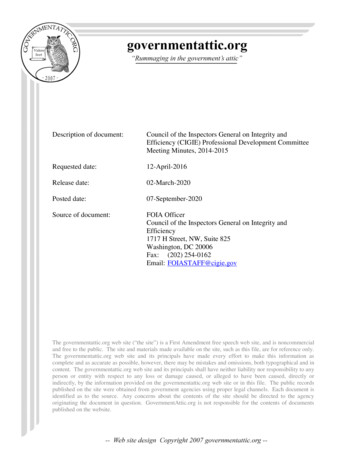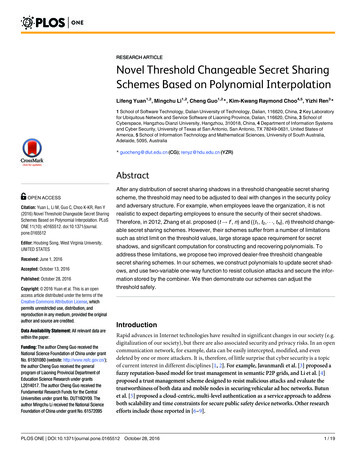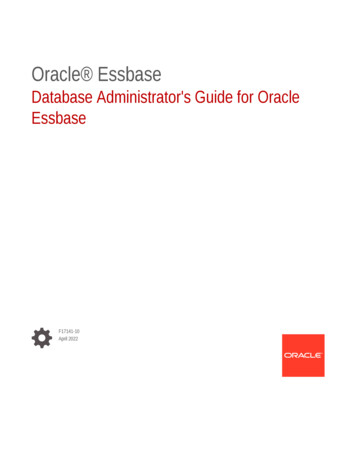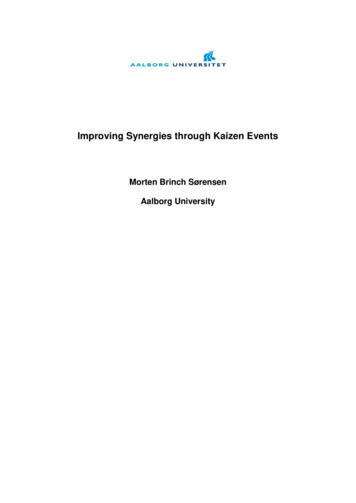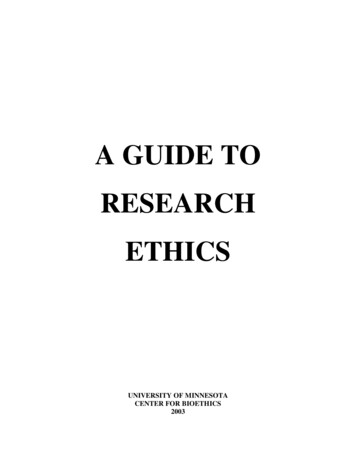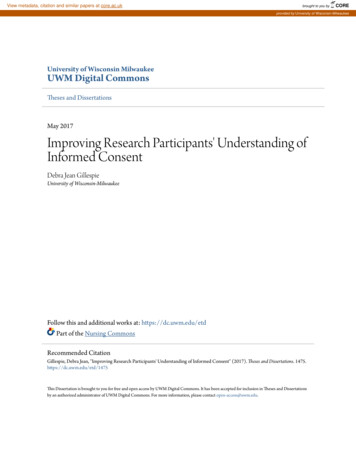
Transcription
View metadata, citation and similar papers at core.ac.ukbrought to you byCOREprovided by University of Wisconsin-MilwaukeeUniversity of Wisconsin MilwaukeeUWM Digital CommonsTheses and DissertationsMay 2017Improving Research Participants' Understanding ofInformed ConsentDebra Jean GillespieUniversity of Wisconsin-MilwaukeeFollow this and additional works at: https://dc.uwm.edu/etdPart of the Nursing CommonsRecommended CitationGillespie, Debra Jean, "Improving Research Participants' Understanding of Informed Consent" (2017). Theses and Dissertations. 1475.https://dc.uwm.edu/etd/1475This Dissertation is brought to you for free and open access by UWM Digital Commons. It has been accepted for inclusion in Theses and Dissertationsby an authorized administrator of UWM Digital Commons. For more information, please contact open-access@uwm.edu.
IMPROVING RESEARCH PARTICIPANTS’ UNDERSTANDINGOF INFORMED CONSENTbyDebra J. GillespieA Dissertation Submitted inPartial Fulfillment of theRequirements for the Degree ofDoctor of Philosophyin NursingatThe University of Wisconsin-MilwaukeeMay 2017
ABSTRACTIMPROVING RESEARCH PARTICIPANTS’ UNDERSTANDINGOF INFORMED CONSENTbyDebra J. GillespieThe University of Wisconsin-Milwaukee, 2017Under the Supervision of Professor Rachel SchiffmanTwenty-five to sixty percent of research participants are unable to understand importantinformation during the research consenting process. This lack of comprehension mayunintentionally expose research participants to potential harm. The purpose of this study was totest the teach back method of communication as an intervention to improve research participants’understanding of informed consent. The Shannon Weaver Communication model was thetheoretical framework supporting this study. The pre-intervention sample (control group) of 18participants enrolled in a cardiology clinical trial at a large tertiary hospital in New Englandcompleted the Quality of Informed Consent (QuIC) survey. Two cardiology researchcoordinators were trained in teach back communication as the intervention. A post-interventionsample (experimental group) of 5 participants completed the QuIC survey.There was no significant difference in mean scores of objective understanding betweenthe pre-intervention and post intervention groups. There was also no significant difference in therelationship between objective and subjective understanding in the pre-intervention groupcompared to the post intervention group. There was poor understanding of compensation forresearch-related injury where 50% of the pre-intervention group and 60% of the post interventiongroup were either unsure or answered questions related to this concept incorrectly.ii
Another poorly understood concept was with a description of the procedures to befollowed. Sixty-one percent in the pre-intervention and no one in the post intervention groupunderstood this concept. A Chi-square test for independence indicated no significant associationbetween highest educational level obtained and understanding of compensation for researchrelated injury or an understanding of procedures to follow.With the uncovering of a poor understanding of the two concepts of compensation forresearch-related injury and procedures to follow, not reported in the literature, more researchspecifically targeting these concepts and participants’ understanding are warranted. Inductiveand deductive approaches may yield interesting results. Institutional and national policies need tobe put into place assuring participant understanding of all regulatory requirements. However, thepractical application of such policies cannot be mandated until there is comprehensive scienceavailable to support its practice.iii
Copyright by Debra J. Gillespie, 2017All Rights Reservediv
TABLE OF CONTENTSList of Figures . viiiList of Tables . ixList of Appendices .xAcknowledgements . xiCHAPTER 1.STATEMENT OF THE PROBLEM .1Informed Consent for Research .1Background .2Problem Statement .6Theoretical Framework .11Purpose of the Study .16Research Question and Hypothesis .16Significance to Nursing.17Chapter Summary .20Structure to Dissertation .21CHAPTER 2.REVIEW OF THE LITERATUREChapter Introduction .22Manuscript One: A Critique of the Shannon Weaver Theory of CommunicationTitle Page .23Abstract .24Introduction .25The Origins of the Theory.25The Meaning of the Theory .26The Logical Adequacy of the Theory .27The Usefulness of the Theory .28The Generalizability of the Theory .30The Testability of the Theory .31Significance to Nursing.32Conclusions .33References . 35-38Manuscript Two: Interventions to Improve Research Participants’Understanding of Informed Consent: A Systematic Review .40Title Page .41Abstract .42Introduction .43Methods.44Results .45PRISMA Literature Search Process .45Interventions .46Modifications/Supplements to the Informed Consent Document .46v
Education .52Monetary Reward.53Communication .54Multi-Media .57Discussion .61Limitations .62Conclusions .63Evidence Table. 64-67References . 68-74Chapter Summary .75CHAPTER 3.METHODS .76Methods.78Measurements .79Procedures .80Data Collection .82Data Analysis .83Limitations .84Chapter Summary .85CHAPTER 4.RESULTS .86Preliminary Analyses: Pre-intervention Group .86Preliminary Analyses: Post intervention Group .88Primary Analyses .95Additional Analyses .96Manuscript Three: Research Participants’ Understanding of Informed ConsentTitle Page .99Abstract .100Introduction .101Background .101Methods.102Results .104Discussion .109Limitations .112Conclusions .112References . 114-116Chapter Summary .117CHAPTER 5.SYNTHESIS OF STUDY .118Major Finding from the Study .118Limitations .121Implications for Nursing .122Implications for Policy .123Implications for Research .127Chapter and Dissertation Summary .130vi
REFERENCES . 131-145APPENDICES . 146-163Appendix A: IRB Approval University of Wisconsin .146Appendix B: IRB Approval Maine Medical Center .147Appendix C: Cover Letter .148Appendix D: Demographic Information Sheet .149Appendix E: Quality of Informed Consent Instrument. 150-152Appendix F: Reminder Postcard .153Appendix G: Teach Back Educational Presentation . 154-161Appendix H: Teach Back Quiz . 162-164CURRICULUM VITAE . 165-168vii
LIST OF FIGURESFigure 1. Shannon Weaver Model of Communication .13Figure 2. Modified Shannon Weaver Model of Communication .14Figure 3. Shannon Weaver Model of Communication .39Figure 4. PRISMA Literature Search Process .45Figure 5. Post Intervention Group Mean Scores by Domain .93Figure 6. Pre and Post Intervention Group Mean Scores by Domain .95Figure 7. Pre-Intervention Group Mean Scores by Domain .108viii
LIST OF TABLESTable 1. Evidence Table . 64-67Table 2. Post Intervention Sample Demographics .91Table 3. Post Intervention QuIC Domain, Concepts and Percent Correct.94Table 4. Post Intervention Participants’ Mean (SD) Scores QuIC Part A and B.95Table 5. Pre-Intervention Sample Demographics .105Table 6. Pre-Intervention QuIC Domain, Concepts and Percent Correct .106Table 7. Pre-Intervention Participants’ Mean (SD) Scores QuIC Part A and B .108ix
ACKNOWLEDGEMENTSThis study was supported, in part by the Holly Gimpel Research Award from SigmaTheta Tau International’s Kappa zeta-at-large Chapter.I would like to express my deepest gratitude and thanks to my committee chair, Dr.Rachel Schiffman. Her high standards challenged me to keep moving the bar higher to makeevery revision and editorial change a better product. I appreciate the enthusiasm and energy shedisplayed for my chosen topic, a topic I believed in wholeheartedly, but feared no one wouldappreciate the passion I feel for it. I would also like to thank my committee members, Dr. AaronBuseh, Dr. Hayeon Song, and Dr. Carol Klingbeil whose expertise was invaluable to me on thisjourney. I would like to thank Dr. Paul Han who was instrumental in navigating the healthcaresystem and introducing me to the right people to make this study a reality. I would also like tothank Dr. Douglas Sawyer for recognizing the importance of this study by providing me accessto his Cardiac clinical trial participants.Finally, I would like to thank my husband, Jim, and many nursing friends and colleagueswho supported me during challenging times recognizing I would never be content until I realizedmy personal and professional dream of completing this dissertation and obtaining my doctoratein nursing.x
CHAPTER 1 STATEMENT OF PROBLEMAccording to the Institute of Medicine (IOM) more than 177,000 registered researchstudies involving human participants are currently taking place in 187 countries representing asmall portion of ongoing clinical research worldwide (IOM, 2013). With every clinical trial thereare inherent risks about which every individual needs to be informed before making a decision asto whether or not to participate. There is a body of knowledge demonstrating that researchparticipants have significant misunderstandings about the potential benefits, risks and otheraspects of their research study (Barrett, 2005; Bergenmar, Molin, Wilking, & Brandberg, 2008;Flory & Emanuel, 2004; Hietanen, Aro, Holli, Schreck, Peura, & Joensuu, 2007; Jefford et al.,2010; Joffe, Cook, Cleary, Clark, & Weeks, 2001; Meade, 1999; Palmer & Trott, 2013; Paris etal., 2007; Schwartz & Appelbaum, 2008). As many as 25-60% of research participants areinadequately informed and/or are unable to recall or understand important information during theresearch consenting process (Aaronson, et al., 1996; McCarthy, Waite, Curtis, Engel, Baker &Wolf, 2012). If research participants agree to enroll into a research study without trulyunderstanding all aspects of the study they might unintentionally be exposed to potential harmThe purpose of this study was to empirically test the teach back method of communication inresearch participants as a method to improve objective understanding of informed consent.Informed Consent for ResearchObtaining informed consent for research is not just the signing of a document, but rathera process of developing a relationship between the investigator or member of the research teamand the potential research participant, in order to provide the participant with the full andcomplete information needed to make a voluntary informed decision including time to havequestions about the research study answered. Research studies may expose participants to risks1
or burdens they would not normally face. It is therefore imperative that potential researchparticipants be knowledgeable about these risks and burdens through the informed consentprocess (Wendler & Grady, 2008). Clear communication and an assessment of participantunderstanding are a critical part of the relationship between the investigator and the potentialresearch participant. Informed consent can be said to have been given by a participant once theparticipant has acknowledged they have a clear appreciation and understanding of the facts,implications, and future consequences of an action.BackgroundIn 1932 the United States Public Health Service began a research study to investigate theclinical course and progression of syphilis. Black, African American men living in Alabamawere recruited to participate by the offer of free medical care. The majority of the men recruitedby the investigators were sons and grandsons of slaves, impoverished and had never seen adoctor or received medical care. Thus, the men showed up in hordes. While being screened forthe study’s inclusion criteria of having venereal disease, the research physicians never disclosedto the participants they had syphilis. As physicians studied the natural progression of syphilis, forfurther enticements, families were offered fifty dollars towards burial insurance. With the newdiscovery of penicillin as a powerful treatment for syphilis, the treatment was withheld to theresearch subjects in order for the physicians to monitor the diseases progression. The researchersjustified the lack of treatment by explaining that these men would not normally be receivingmedical care, so why miss the opportunity to study the natural progression of the disease. Thestudy was originally designed to last 6 months, but continued to enroll and monitor syphilisstricken men for forty years. The study came to an abrupt halt in 1972 when it became public2
knowledge after one of the former venereal disease investigators disclosed to a reporter theunethical conduct of the study (Thomas, 2000).An institution on Staten Island, New York, named Willowbrook served the mentallyretarded population from 1947-1987. A research study, partly funded by the United StatesArmed Forces, Department of Epidemiology, was undertaken in 1955 to study the progression ofand treatment of hepatitis. Children living at Willowbrook were purposely fed fecal matterextract and given doses of the live hepatitis virus. Although parental consent was obtained, theinvestigators did not disclose to parents the risks of participation (Robinson & Unruh, 2008).Investigators had discovered high rates of hepatitis among the residents at Willowbrook andhypothesized that if children were deliberately given an injection of live hepatitis viral strain,they would develop immunity. The hepatitis experiments at Willowbrook are commonly cited asone of the most serious ethical breaches since the Nazi human experimentations of World War II(Robinson & Unruh, 2008).In response to the travesties of the Nazi human experimentations during World War II,and the unethical conduct of research involving human subjects from the Tuskegee Study, andthe Hepatitis study at Willowbrook, the National Commission for the Protection of HumanSubjects of Biomedical and Behavioral Research published a landmark report, “EthicalPrinciples and Guidelines for the Protection of Human Subjects for Research” commonlyreferred to as the Belmont Report (National Commission for Protection of Human Subjects ofBiomedical and Behavioral Research, 1979). Contained within the Belmont Report are threeethical principles guiding research conduct with human participants. These principles includerespect for persons, beneficence and justice. The focus of this paper is the principle of respect forpersons, which honors individuals’ right to choice and emphasizes potential research participants3
must have the capacity to consent as well as comprehend any risks and benefits (Shuster, 1997).Working within this principle, investigators are required to provide a consent process to potentialresearch participants with sufficient knowledge and understanding of research for informeddecision making (Whitney, 2001).It is common for research consent forms to contain structured and technical language todisclose participants’ rights and responsibilities (Institute of Medicine, 2004). The practice hasbeen that informed consent documents are typically written at the same reading level as paperswritten for medical journals (Green, Duncan, Barnes, & Oberklaid, 2003). In addition, theinformed consent process is often seen as “bureaucratic form filling” rather than an importantand necessary part of the research process requiring time, insight and communication skills(Banner & Zimmer, 2012). Institutional Review Boards (IRB) often provide investigators withtemplates for writing informed consent documents that satisfy the IRB’s requirements but do nottake into account the specific verbiage needed for the study’s population.For research participants to give informed consent, four conditions must be met:disclosure, comprehension, capacity to understand and voluntary nature (Iltis, 2006). Forcomplete disclosure investigators must provide potential participants with sufficient informationregarding the nature and purpose of the study, the risks and benefits, alternatives, costs andprotection of confidentiality. Comprehension refers to the language used in the informed consentdocument and must be at a level potential research participants can understand. Capacity tounderstand refers to research participants being legally competent and able to appreciate theinformation given to them and finally, participation in research must be voluntary in nature withthe option of declining to participate while not jeopardizing their clinical care or right to otherresources (Iltis, 2006).4
The essential elements of informed consent are defined in the United States Departmentof Health and Human Service’s Code of Federal Regulations (CFR) and include: the purpose ofthe research, risks and benefits of participation, voluntary nature of participation, a distinctionbetween research and clinical care, potential for compensation for a research-related injury, theopportunity to ask questions and alternatives to participation (Office of Human ResearchProtection, 2009). The CFR’s has recently been revised and several sections on informed consenthave been updated specifically in regards to “new requirements relating to the content,organization and presentation of information included in the consent form to facilitate aprospective subject’s decision about whether to participate in research ” (Federal Register,2017, p. 7210). The impetus for these changes came from arguments stating that consent formshave evolved over time to be documents more designed to protect institutions from liabilityrather than provide individuals with decision-making information, along with the growing lengthand complexity of these forms making reading and comprehension difficult (Beardsley, Jefford,& Mileshkin, 2007; Federal Register, 2017). These new regulations take effect January 2018 soit remains to be seen what if any effect there will be to participants’ understanding as a result.Obtaining informed consent for research is essential for ethical conduct and arequirement of these federal regulations (Flory & Emanuel, 2004). To make the consent processtruly informed, participants must be given sufficient, understandable information to allowindependent decision making (Lansimies-Antikainen, Pietila, Laitinen, Schwab, Rauramaa, &Lansimies, 2007). This honors individuals’ autonomy and protects them from potential harm(Antoniou, Draper, Reed, Burls, Southwood, & Zeegers, 2011). Research participants’ signing ofa consent form serves as documentation of their consent and voluntary participation and satisfies5
legal and ethical requirements (Armstrong, Dixon-Woods, Thomas, Rush, & Tarrant, 2012;Banner & Zimmer, 2012).In 2007 the Food and Drug Administration (FDA) Amendment Act mandated theregistration of human subjects’ research involving drugs and/or medical devices approved for usein the United States (Califf, Filerman, Murray, & Rosenblatt, 2012). The National Institute ofHealth (NIH) developed the database (clincialtrials.gov) for the registration. Each week morethan 330 research studies are registered on the database, which is the repository for more than177,000 studies (Califf et al., 2012). The Clinical Trials Cooperative Group, which is sponsoredby the National Cancer Institute (NCI) registers more than 25,000 research participants everyyear from more than 3,100 organizations which include more than 14,000 research investigatorsin the United States, Canada, and Europe (National Cancer Institute, 2009). Given the largevolume of research studies currently being conducted, and the plethora of research demonstratingparticipants’ lack of understanding of informed consent for research, it is imperative thatinterventions to address the issue of respect for persons, including improving comprehension ofinformed consent be addressed.Problem StatementClear communication is an important element of healthcare quality and patient safety(Institute of Medicine, 2001), yet 47% of Americans, roughly, 90 million, have difficultiesunderstanding health information given to them by their providers (Wilson, 2009). It has beendocumented that patients absorb and recall only about half of what physicians havecommunicated to them (Schillinger et al., 2003). In addition, approximately 40-80% of medicalinformation is forgotten almost immediately with the greater the amount of information beinggiven proportional to the amount of information forgotten (Kessels, 2003). Adding to these6
alarming statistics is the difficult readability of informed consent documents, particularlydocuments for research participation. Readability is described as the person’s ability to read andunderstand written material (Redish & Selzer, 1985). A document’s readability is determined bya mathematical formula applied to written texts in order to predict how difficult the material willbe for any group to read and understand. This is determined by counting the number of syllablesper word and number of words per sentence (Buccini, Iverson, Caputi, & Jones, 2010).Readability scores are expressed as a grade level equivalent to the number of years of formalWestern education. Nearly h
University of Wisconsin-Milwaukee Follow this and additional works at:https://dc.uwm.edu/etd Part of theNursing Commons This Dissertation is brought to you for free and open access by UWM Digital Commons. It has been accepted for inclusion in Theses and Dissertations by an authorized administrator of UWM Digital Commons.



